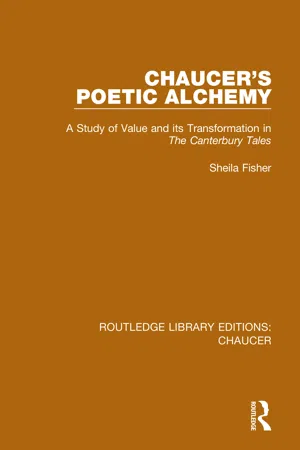
Chaucer's Poetic Alchemy
A Study of Value and its Transformation in The Canterbury Tales
- 264 pages
- English
- ePUB (mobile friendly)
- Available on iOS & Android
Chaucer's Poetic Alchemy
A Study of Value and its Transformation in The Canterbury Tales
About This Book
Originally published in 1988. The economic changes and the growth of commerce in fourteenth century England precipitated both social changes and a preoccupation with material wealth. This book examines Chaucer's treatment of economic and ethical value in The Canterbury Tales within the context of contemporary economic and social change and in relation to the scholastic economic theory that attempted to formulate ethical standards for commercial conduct. The importance of value and its determination and transformation is evident from the two enterprises that Chaucer defines as the motivating principles for his poem. The pilgrimage to St. Thomas's shrine should effect a transformation of their spiritual value. The story-telling competition that produces the tales themselves is established to judge the value of the pilgrims' literary productions. In the Middle Ages, economic value and ethical value were not perceived as unrelated phenomena. Chaucer's concern with the interrelationship of material and moral value is apparent in the number of pilgrims who are interested in material value at the obvious expense of moral value. This book examines this along with a discussion or money's growing importance in the late Middle Ages and the determination of its value.
Frequently asked questions
Information
Chapter IV
Chaucer and the “‘Slidynge Science’”: Value and its Alchemical Transformation in The Canon’s Yeoman’s Prologue and Tale
“. . . al this ground on which we been ridyng,Til that we come to Caunterbury toun,He koude al ciene turne it up-so-doun,And pave it al of silver and of gold.”1
Table of contents
- Cover
- Half Title
- Title Page
- Copyright Page
- Original Series Page
- Original Title Page
- Original Copyright Page
- Acknowledgments
- Table of Contents
- INTRODUCTION
- I. “AL HAVE I NAT SET FOLK IN HIR DEGREE”: THE QUESTION OF VALUE IN THE WORLD OF THE CANTERBURY TALES
- II. WHAT WOMEN MOST DESIRE: VALUE AND ITS DETERMINATION IN THE WIFE OF BATH’S PROLOGUE AND TALE
- III. “‘WE MAY CREAUNCE WHIL WE HAVE A NAME’”: TAKING IT ON FAITH IN THE SHIPMAN’S TALE
- IV. CHAUCER AND THE “‘SLIDYNGE SCIENCE’”: VALUE AND ITS ALCHEMICAL TRANSFORMATION IN THE CANON’S YEOMAN’S PROLOGUE AND TALE
- EPILOGUE: CHAUCER’S POETIC ALCHEMY AND THE TRANSFORMATION OF THE CANTERBURY TALES
- BIBLIOGRAPHY